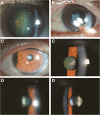Cataract subtype risk factors identified from the Korea National Health and Nutrition Examination survey 2008-2010
- PMID: 24410920
- PMCID: PMC3928645
- DOI: 10.1186/1471-2415-14-4
Cataract subtype risk factors identified from the Korea National Health and Nutrition Examination survey 2008-2010
Abstract
Background: To assess the socio-demographic and health-related risk factors associated with cataract subtypes in Korea.
Methods: A total of 11,591 participants (aged ≥40 years) were selected from the Korean National Health and Nutrition Examination Survey between 2008 and 2010. The Korean Ophthalmologic Society conducted detailed ophthalmologic examinations on these participants based on the Lens Opacity Classification System III. Risk factors for developing any type of cataract, and its subtypes (nuclear, cortical, posterior subcapsular and mixed), were identified from univariate and multivariate logistic regression analysis.
Results: The prevalence of cataracts was 40.1% (95% CI, 37.8 - 42.3%) in participants over 40 years old. Older age, lower monthly household income, lower education, hypercholesterolemia, hypertension, and diabetes mellitus (DM) were independent risk factors for development of any cataract. Older age, lower monthly household income, lower education, hypercholesterolemia, and DM were independent risk factors for development of pure cortical cataracts. Older age, lower education, metabolic syndrome, and DM were independent risk factors for development of pure nuclear cataracts. Older age and DM were independent risk factors for development of pure posterior subcapsular cataracts. Older age, lower monthly household income, lower education, and DM were independent risk factors for development of mixed cataracts.
Conclusion: Although socioeconomic disparities are related to cataract development, this study identified several "modifiable" risk factors that may help to lower the incidence of cataracts and associated vision loss. Improved control of blood pressure, blood, glucose, and cholesterol may help to reduce the incidence of cataracts in the general Korean population.
Figures




References
-
- Hiller R, Sperduto RD, Ederer F. Epidemiologic associations with nuclear, cortical, and posterior subcapsular cataracts. Am J Epidemiol. 1986;124(6):916–925. - PubMed
-
- Hiller R, Sperduto RD, Podgor MJ, Wilson PW, Ferris FL 3rd, Colton T, D’Agostino RB, Roseman MJ, Stockman ME, Milton RC. Cigarette smoking and the risk of development of lens opacities. The Framingham studies. Arch Ophthalmol. 1997;115(9):1113–1118. doi: 10.1001/archopht.1997.01100160283003. - DOI - PubMed
-
- Klein BE, Klein R, Lee KE. Diabetes, cardiovascular disease, selected cardiovascular disease risk factors, and the 5-year incidence of age-related cataract and progression of lens opacities: the Beaver Dam Eye Study. Am J Ophthalmol. 1998;126(6):782–790. doi: 10.1016/S0002-9394(98)00280-3. - DOI - PubMed
Publication types
MeSH terms
LinkOut - more resources
Full Text Sources
Other Literature Sources
Medical

